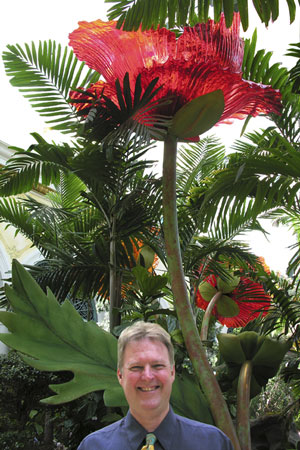
 In Tiffany Glass Garden at
Bellagio Hotel, Las Vegas, NV 2004 |
About the artist . . .
Michael Hopkins received his first indication of the depth of his
talent at age eight. After one art class with his peers, his
instructor informed him that he was ready to take classes at the adult
level, which he did. By age twelve, Michael was studying at the
Flemish Art Shop of Sherman Oaks, California. His artistic
prowess at Notre Dame High School led to a two-year scholarship
allowing him to attend Saturday afternoon college-level classes at
Hollywood’s Art Center College of Design. It was there that
he studied drawing models, focusing on capturing the subtleties of
various costumes.
After his graduation in 1969, Michael painted intensely for thirteen years, selling many works and receiving numerous commissions. During this time he also became an accomplished musician. By 1982, Michael’s success in that field forced a hiatus from his art. He soon realized, however, that he could never abandon his painting and drawing. In 1992, he enrolled at Cuesta College in San Luis Obispo, California to refresh his skills. In 1994, still in San Luis Obispo, Michael discovered the possibilities of computer art. Trained by the MacTeacher School, he himself became a computer art teacher within six months and joined the staff of a local print studio as a graphic artist shortly thereafter. Michael’s original purpose for learning to navigate the world of computer graphics was to scan, photograph and digitize his entire portfolio inorder to create fine art prints, an endeavor which is still far from completion. But once he discovered the infinite possibilities of the Macintosh as a powerful tool for creating beautiful art, he began to paint with a mouse. He also discovered that his digitized real world canvasses could be enhanced using his computer. After living for 6 years in the Santa Cruz mountains he moved south and is currently a resident of Poway, in San Diego county. Michael’s portfolio is a compelling tapestry of works generated by cutting edge art and design programs, traditional tools and media, and myriad combinations of the two. -Written by Greg Burrill
(fellow musician, philosopher, teacher & long time friend) |
